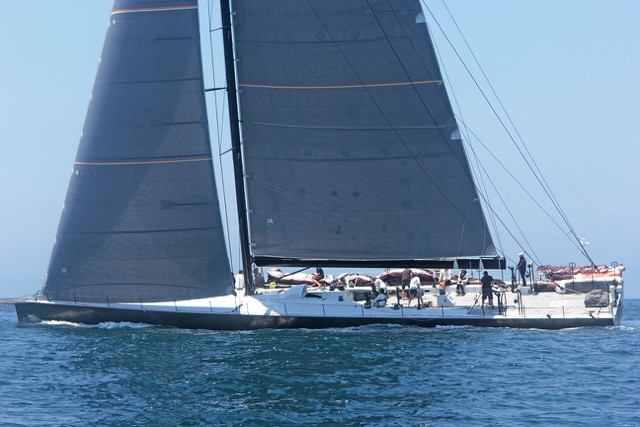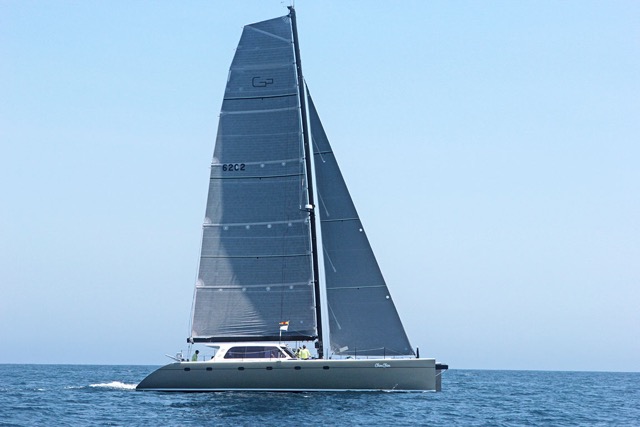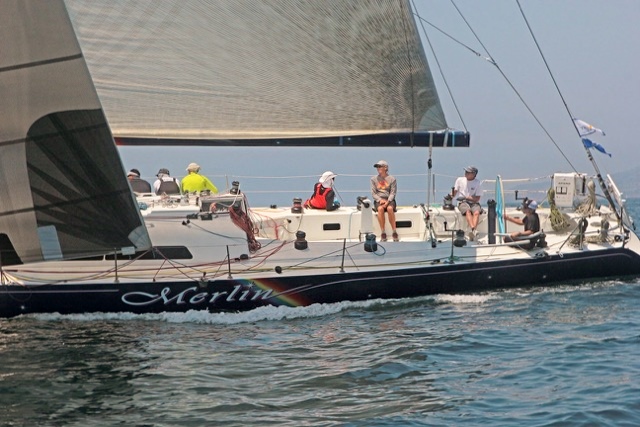Here is an interesting yacht from designer Gabriel Heyman. The Celeste 36 is a performance cruiser built on a semi-custom basis in Sweden. It combines an interesting blend of cruising and performance features in a conservative aesthetic package. This is a refreshing departure from the current trend in production cruising boats that seem to be inspired by IKEA-like styling. For an experienced cruising sailor, having a boat customized to your specific needs can be a far more interesting and rewarding experience than buying a production boat off the showroom floor.
 |
Celeste 36
Moderate proportions, conservative styling and good performance potential. |
Let's start with the hull of the Celeste. The stem is not quite vertical and the transom is reversed about fifteen degrees. I find that having a small amount of rake in the stem is visually more interesting than a plumb bow. The sheer is gently sprung and matches the somewhat retro styling of the cabin trunk. In the plan view, the boat's narrow beam is apparent. The bow at deck level is quite full and incorporates a molded-in bowsprit. The beam at the transom appears to be about 9.00 feet which allows for a spacious cockpit as well as plenty of volume aft. Below the waterline, the hull sections are smooth arcs. I'm glad to see that Heyman resisted the temptation to add chines. This hull shape is reminiscent of Rodger Martin's Aerodyne 38, which is a very quick cruiser/racer. I would guess the Celeste 36 has a fairly high prismatic coefficient, so it won't generate large bow and stern waves when traveling at hull speed. On the other hand, with a Sail Area/Displacement ratio of 22.4 and a non-overlapping headsail it might be a bit sticky in light air. In general, narrow boats tend to have better sailing qualities than beamy ones and I think the Celeste will reward you with good speed and good manners in a seaway.

;llkkj
 |
Underwater view.
Note the relatively fine waterlines forward and moderately proportioned keel. |
Below the waterline, the Celeste incorporates a vertical fin/bulb keel that draws 6.00 feet. I am intrigued by the small skeg. There is no hydrodynamic reason for this feature, and I would prefer to see the rudder fitted right up to the fairbody of the hull. Aside from that minor detail, the hull looks quite slippery. With a displacement/length ratio of 170, this boat is light enough to provide respectable downwind performance and should be a lot of fun to drive hard upwind.
The deck is a study in conservative efficiency. The cabin trunk is low and nicely proportioned, It's rounded edges blend well with the "curviness" of the hull. To my eye, this is a welcome contrast from the boxy angularity of many modern cruisers. Side decks are wide enough and the cockpit is large enough for comfortable cruising. In the plan view below, note the long jib tracks and the transverse traveler just forward of the mast for a self tacking jib. In the windier parts of the world, the small self-tacking jib would be fine, but here in southern California, it wouldn't provide enough power so I'm glad to see the designer included the jib tracks. The deckplan below shows halyards and control lines led outboard to the edges of the trunk. At first glance this doesn't appear to be a good solution, but the builder cleverly buried the lines within the cabin trunk.
 |
| Halyards led outboard and buried in the cabin trunk. |
The cockpit incorporates quirky hooked coamings around the seats, with spinnaker winches located just outboard of the "hooks". I'd have to try out this arrangement before passing judgment, but it looks a bit cumbersome to me, with little clearance for winch handles. The Celeste is narrow enough that a single helm is sufficient and the aft end of the cockpit is arranged to allow the helmsman to sit outboard. There is a plethora of small hatches for rope stowage etc. and a fold-down panel in the transom to create a boarding platform. I'm not a fan of this feature. I would rather see a step or platform molded into the transom.
 |
Celeste 36 deck.
I like the solid bow plank, which will help keep the rode from chafing the hull when at anchor. The cockpit is busy, but well appointed for cruising. |
 |
| A nice balance of comfort and sailing efficiency. |
I like the proportions of the sailplan. With the chainplates located at the sheer, the jib is limited to about 105% which means it will be easy to handle in all conditions. The mainsail is large and full-battened. It is controlled by the mainsheet led to a single block on the cockpit sole instead of to a traveler. This arrangement sacrifices a bit of upwind ability for simplicity and, given the cruising orientation of the boat, this is a reasonable trade-off. This is a powerful rig for a cruising boat and you'll want an efficient reefing system for it. The photos show a carbon fiber mast and boom, but I'm sure you can order your Celeste 36 with aluminum spars too.
 |
Celeste 36 under symmetrical spinnaker. The boat can also accommodate
asymmetrical spinnakers tacked to the bowsprit. |
Since this is a semi-custom boat, the options for accommodations are plentiful. I've included two variations below. In the first one, the forward cabin is spacious with a large V-berth, hanging locker to port and a small bureau to starboard. Just aft of this area is a large nav station to port and enclosed head to starboard. The head features access from the salon and forward cabin. One of the compromises in the nav area is the lack of a fixed seat. Mr. Heyman solved this problem by incorporating a swing-out bar stool type seat. I tried this arrangement early in my career and discovered that it doesn't work very well, especially when underway. A better approach would be to incorporate a fold-down seat attached to the furniture built around the mast. I love the size of the chart table though.
The main salon incorporates a centerline dropleaf table flanked by port and starboard settees with outboard shelves. The settees are a bit short for my taste, but I think this is a reasonable compromise in a 36 foot boat. Aft of the settees, the galley is split, with the stove and reefer to port and the double sink and counter to starboard. This arrangement would take some getting used to.
Aft of the galley are a pair of single quarter berths. These would be quite comfortable underway and allow for excellent access all around the engine, which is located in a box behind the companionway stairs. I'm a big fan of good engine access.
 |
| Salon in the split galley version. |
 |
| Looking aft from the nav station. |
The accommodations plan below is more conventional. It is identical to the other plan forward of the mast, including the head and nav station. The salon incorporates a starboard settee berth that appears to be long enough to use as a sea berth. The galley is to port and there is a quarter cabin to starboard. Aft of the galley is a large storage locker accessible from the cockpit. This would be a comfortable boat for coastal or distance cruising.
 |
| All photos courtesy of Heyman Yachts. |
When I do these design reviews, I consider performance, comfort and practicality along with aesthetics. Overall I give the Celeste 36 high marks for originality and performance potential. As a coastal cruiser, it provides everything I would need to be comfortable. Aesthetically, I think it's a splendid example of the blending of the art and science of yacht design. While it's unlikely that a Celeste 36 is going to appear in a marina near me, if one did, I'd jump at the chance to go sailing aboard one. For more information visit www.Heymanyachts.com.

































